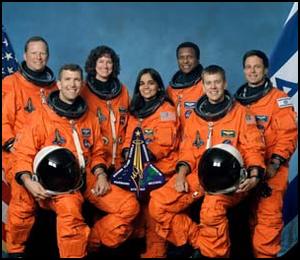Writes the chairman of a track, a student cell for the topic of space, the day after the disaster
In the photo: The head of NASA, Sean O'Keefe clapped his hands in the face at the press conference on Tuesday, eight in the evening Israel time
Yesterday, at 1400 GMT, contact was lost with the space shuttle Columbia, which was on its way to land in Florida after the end of mission 107. A few minutes later, the pictures began to arrive showing the shuttle burning up at the entrance to the atmosphere. The seven crew members of the ferry and their son Ilan Ramon, perished.
Since the dawn of time, humans have set out to explore the world in which we live, Magellan, Columbus, Marco Polo and others marked the path between Europe and the rest of the world and brought great wealth and prosperity to the old continent. But in addition to the researchers who became famous, there are a large number of other researchers who fell in the line of duty - whether it was trying to reach the South Pole or trying to circumnavigate the world.
When Yuri Gagarin became the first cosmonaut, a new land was opened to the human race - but disasters were not long in coming. Vladimir Komarov died when the Soyuz spaceship he was in crashed, the Apollo 1 crew burned in the spaceship while it was being tested on the ground and the most famous disaster of all - the Challenger crash in which seven people died. Yesterday, seven more names were added to this sad list, including the first Israeli astronaut. But this, despite the grief, is a known risk. When those astronauts boarded the shuttle they were as well aware of the risk involved as any other astronaut. Space exploration is a dangerous thing. Failures are not unusual, on the contrary, they are part of the game. Therefore, despite the terrible disaster, we must not give up - we must continue with more determination on our way to the stars and fulfill the legacy of the fallen.
In the coming days and weeks, the American space agency will find the failures that caused the accident and draw the conclusions. But we have the duty to continue promoting space exploration, to continue our journey to places far from the earth, to continue the path of the astronauts who perished.
We lost two space shuttles but we must not let the space program freeze because without a future we have no existence. If we don't demand a space program that is bolder, more innovative and reaches new heights then the space program will die. For the future of our children, that one day they will be able to look up to the stars and know that there are humans out there in the distance, we must keep the torch lit.
Despite the heavy disaster we must realize NASA's vision - improve our lives here, explore space there, and find life beyond. As the future generation, we must dare to keep flying, dare to board a spacecraft on the way up, dare to dream so that in fifty years we will look around and see a flourishing human society.
Daniel Rosenberg
Track chairman
israspace@yahoo.com
In the service of humanity/coverage of the "Columbia" ferry crash

The Columbia crash on channel 10. An image that emphasizes the aspect of "expanding the envelope"
2.2.2003
By: Rogel Alper, Haaretz, courtesy of Walla
The American space program appears in popular culture as part of the overall self-image of the American nation as a buffer, the goat that walks at the head of the herd, of humanity: pioneering, innovative, brave. Self-images. The slogan of the successful science fiction series "Star Trek" is "To boldly go where no Man has gone before". It distills the popular image of the astronaut as the spearhead of humanity, who boldly goes to regions where no man has gone before.
He embodies the curiosity, the desire for knowledge - the qualities that drive science - and therefore the modern man as he is, the advance, the technological sophistication, the systematic exploration of the universe. An astronaut is a cultural hero and his death is always a heroic death, because he sacrificed himself in the service of the scientific human enterprise.
At the press conference, the heads of the American space agency emphasized the key concepts of the astronaut halo and the American nation. That "expansion of the envelope" and "breaking the boundaries of human science" - the empowering, essential qualities of the American national identity. They suggested that the space plant would not stop. An investigation will be conducted, lessons will be learned - and they will move on. Even in a difficult and tragic moment, it was evident that it was important for official America to demonstrate the power of its own power. A glitch has occurred, America will move on. American films are full of heroes who, in their death, commanded, a spiritual testament, that others would continue on their way. This is always the case when a death occurs in a context that gives it a broad meaning. In the case of astronauts, their death has meaning in relation to all of humanity. This is why astronauts from many countries participated in the shuttle flights. All of humanity, led by America, flew into space.
Even at President Bush's press conference, the popular image shaping mechanism of the space program and the astronauts could be seen in action. Bush spoke of a "noble cause", of "boldness, idealism and courage", of the "longing to understand" the "darkness" that prevails "beyond our world", that the astronauts took "a risk in the service of all humanity", and that "the journey will continue". The death of the astronauts is presented as a moment of mass metaphysical reflection, which returns all of humanity to its basic existential state, from which science and religion grow: alone in the universe, trying to understand, looking for answers to the most difficult questions. And so Bush also reached the inevitable religious part of his speech. Humanity is not an orphan. God created everything, God comforts, God embraced the fallen astronauts, and God, as usual, will bless America.
The photo of the shuttle trail splitting and exploding was, like everything related to the space project, not only newsworthy but symbolic. This is the return from the spaces "beyond our world", from the "darkness". The explosion happened in the atmosphere, at the border between the world and space. That is why it is a visual image, which emphasizes the "mantle expansion" aspect, the pioneering aspect of the astronauts' death. They perished on the border line.
The Israeli broadcasting channels focused on the personal tragedy of Ilan Ramon. They interviewed, live, his grieving brother and father. On Channel 2, the tearful and shocked father was given directing instructions: Look at the camera. The American drama was respectable. The heads of NASA asked the media to respect the privacy of the families in Avlan. The Israeli drama was more invasive, yellowish. The metaphysical aspect has disappeared completely. Photos of grief-stricken relatives remain. Channel 10 posted a reporter outside the fireplace. as in an attack. As if there is no drama, no story, if the floods of sorrow are not recorded an hour after the disaster is known.
A white trail in the blue sky
2.2.2003
By: Ari Shavit, Haaretz, Walla

Ramon and his friends on the journey. Photo: NASA
Everyone who grew up here knows this sight: a white trail on light blue. A white trail in the blue sky. And everyone who grew up here also knows this feeling: inside the white trail is one of our own. One of this Lilliput country, which has almost no land under its feet but its sky is huge. One of this lilpot country that is all dirty and messy - but it has an air force.
Ilan Ramon was one of ours. Not Yuri Gagarin, not Neil Armstrong, but one of our own. Made from these basic materials of Blich and Beer Sheva and Kors Tis. Made from this basic fate of Bin Shoah and the Iraqi reactor. With a captivating smile and a captivating family and some technological patriotic Israeliness of the XNUMXs. With a contemporary incarnation of almost girlish innocence. A small Torah scroll of a Holocaust survivor took with him into space. And the drawing of the earth by a child murdered in Auschwitz he took with him into space. Vans the president and a Bleach flag and a shirt to stop the traffic accidents.
For 16 days we had one of our own in space. And since then he ascended in a white caravan to the great blue of Cape Canaveral in the middle of January, Ilan Ramon was able to say that when he flew over us he saw how small and beautiful we are. And suffice it to say how thin is the atmosphere that surrounds us and enables our lives. And this country, accustomed to cynicism, looked up to its man in space. This country, used to being disgusted with itself, raised its eyes to the surprising possibility that there is, after all, another Israel. An Israel that is able to detach itself from the gravity of its destiny. and investigate the effect of weightlessness on mushrooms. Investigate the effect of weightlessness on kidney stones. To investigate the impact of dust storms on the climate of the Middle East.
Yesterday afternoon the sky was full of white trails. Not a single white trail. Two, three, four white trails. One white trail that becomes two and three and four white trails. And this country of Lilliput, which is all bleak and confused, converged again on this feeling: within the white foothills one of our own. Inside the White Shubals is our other Israel. With a small Torah book and a drawing of the earth and the miracle of the president and a flag of Blich. And this recurring and shattering hope of breaking away from the gravity of our destiny. To float in some weightless normality above the gravity of our existence.
